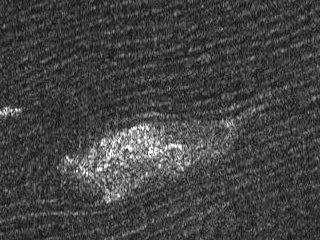Thursday, May 04, 2006
Seas of Sand and Other Alien Things
Lots of activity at the Cassini web page today.
 University of Arizona scientists make a case for Titan's "oceans" consisting of sand, not liquid. Saturn raises tides not in Titan's alleged oceans, but in the atmosphere, driving winds by churning up the moon's orange air.
Over on the left here, you can see some dunes interrupted by a landform, probably a small mountain. Some of these dunes run as long as 900 miles.
Is there any liquid on Titan? The jury's still out on that question. Some scientists suspect that ethane or other low-temperature liquids might occasionally rain out of Titan's atmosphere. A deluge would come along rarely (not unlike Terran desert precipitation), but that would be one possible mechanism for creating these sand grains. And what is this sand? Probably not silicates, as on Earth. It could be water ice eroded from Titan's surface. It could also be precipitation directly from the atmosphere, sort of like miniature hail stones. If that is true, the sand grains are probably made up of organic chemicals, carbon-hydrogen compounds most likely.
University of Arizona scientists make a case for Titan's "oceans" consisting of sand, not liquid. Saturn raises tides not in Titan's alleged oceans, but in the atmosphere, driving winds by churning up the moon's orange air.
Over on the left here, you can see some dunes interrupted by a landform, probably a small mountain. Some of these dunes run as long as 900 miles.
Is there any liquid on Titan? The jury's still out on that question. Some scientists suspect that ethane or other low-temperature liquids might occasionally rain out of Titan's atmosphere. A deluge would come along rarely (not unlike Terran desert precipitation), but that would be one possible mechanism for creating these sand grains. And what is this sand? Probably not silicates, as on Earth. It could be water ice eroded from Titan's surface. It could also be precipitation directly from the atmosphere, sort of like miniature hail stones. If that is true, the sand grains are probably made up of organic chemicals, carbon-hydrogen compounds most likely.
 Cassini's latest pass gathered radar data from the Xanadu region. Over to the right here, check out a possible crater. That round object might also be a caldera--a vent for volcanic activity from below. No word on what the bright objects might be. Remember, this is radar, not b&w photography. Dark areas show smooth terrain, and bright areas show rough going. Given the predominance of those dunes, bright areas might show highlands around which Titan's sand is blown.
The tiny moon Daphnis (relatively tiny; it's about 4 miles wide) and a nice shot of the faint particles in the Cassini Gap.
Also, they're still trying to figure out just how long Saturn's day is.
And lastly, European and American science folks have put together some movies of Titan.
Cassini's latest pass gathered radar data from the Xanadu region. Over to the right here, check out a possible crater. That round object might also be a caldera--a vent for volcanic activity from below. No word on what the bright objects might be. Remember, this is radar, not b&w photography. Dark areas show smooth terrain, and bright areas show rough going. Given the predominance of those dunes, bright areas might show highlands around which Titan's sand is blown.
The tiny moon Daphnis (relatively tiny; it's about 4 miles wide) and a nice shot of the faint particles in the Cassini Gap.
Also, they're still trying to figure out just how long Saturn's day is.
And lastly, European and American science folks have put together some movies of Titan.